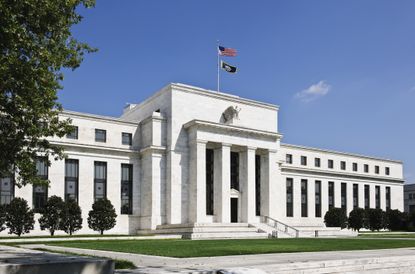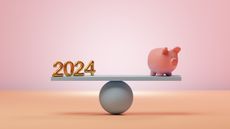10 Bond Portfolio Picks Before the Fed Cuts Rates
How to boost your bond portfolio and take advantage of this perfect storm.


The U.S. bond market is about to enjoy the proverbial best of both worlds. Bond yields, an approximation for annualized bond returns, are high — the Bloomberg U.S. Aggregate Bond index yields 4.6%; U.S. high-quality corporate debt, 5.1%. And interest rates are poised to move lower, which means bond prices will ratchet up. (Interest rates and bond prices move in opposite directions.)
Together, that’s a double leg up for bond market total returns. “I think this is one of the best times to put money to work in the bond market in 20 to 25 years,” says Thomas Urano, a managing partner at Sage Advisory.
So now is a good time to revisit your core bond portfolio. You can always start with a broad bond index fund, such as iShares Core U.S. Aggregate Bond (AGG, yield 4.5%), an exchange-traded fund that tracks the benchmark considered to be a barometer of the bond market. But “each investor has their own goals and risk tolerance,” says Invesco’s Jason Bloom. “Our view is that investors can do better — much better — than just owning the Agg.”

Sign up for Kiplinger’s Free E-Newsletters
Profit and prosper with the best of expert advice on investing, taxes, retirement, personal finance and more - straight to your e-mail.
Profit and prosper with the best of expert advice - straight to your e-mail.
In fact, most active bond fund managers outpace the U.S. Aggregate Bond index over the long haul on average, according to fund-tracker Morningstar. Our favorite active core bond funds, Baird Aggregate Bond (BAGIX, yield 4.2%), Dodge & Cox Income (DODIX, 4.7%) — a member of the Kiplinger 25, our favorite no-load mutual funds — and Fidelity Total Bond (FBND, 5.2%), have each outpaced the Agg over the past one, three and five years. That’s why we prefer starting with an actively managed core bond fund — let an expert do the heavy lifting.
But it may pay to complement your core holding with tactical tilts of exposure to certain bond sectors to enhance performance. We’ll walk you through some simple ways to optimize your portfolio for current market conditions by leaning into bond sectors that are attractive now.
Of course, if you own shares in an active intermediate core bond fund, your manager may be making some of these moves already, so consider any shifts in terms of your overall portfolio. We’ve also included model portfolios, built by Elya Schwartzman at fund firm BondBloxx, as an example of how the pros might enhance yield or lower your portfolio’s sensitivity to interest rate shifts. (Yields and other data are through July 31, unless otherwise noted.)
Mix up the ingredients
To beat the Agg, you’ll want the flexibility to beef up some sectors in your portfolio and de-emphasize others, depending on the market environment. The main ingredients in an investment-grade bond portfolio are Treasuries, corporate debt and mortgage-backed securities, with a dash of government-linked IOUs and asset-backed securities (such as bundled credit card and auto loans).
Start with Treasuries. For now, it makes sense to emphasize Treasuries with maturities between one and 10 years. Although price declines from interest rates moving higher are largely in the rearview mirror, many bond experts still favor short- to medium-term government bonds, which are less sensitive than long-term debt to interest rate swings.
But the yield curve remains inverted, which means shorter-term notes yield more than their long-term counterparts. And when rates start to fall, bond analysts expect yields to dip more on the short end. “We favor short-term because we like the high current yield and safety,” says BondBloxx’s JoAnne Bianco. “And intermediate-term bonds can still capture potential price returns when the Federal Reserve reduces interest rates.”
Funds worth exploring include the SPDR Portfolio Short Term Treasury ETF (SPTS), which currently yields 4.6% and has a duration (a measure of interest-rate sensitivity) of 1.8 years. That implies if rates fall by one percentage point, the fund’s net asset value will rise by 1.8%. Or consider the Schwab Intermediate-Term U.S. Treasury ETF (SCHR), which yields 4.3% and has a duration of five years.
Reach for yield within high-quality corporate debt. “Adding to your exposure to triple-B corporates is a good way to enhance long-term returns,” says Bianco. Corporate bonds rated triple-B are still investment grade, but offer better yields than higher-quality corporate debt and have better long-term returns, too. The trade-off is higher volatility. Over the past decade, triple-B corporate debt was 10% more volatile than the broad corporate-debt market.
If you can stomach the added volatility, consider the iShares BBB Rated Corporate Bond ETF (LQDB), which yields 5.3%. The fund has returned 7.1% over the past 12 months.
Pad the quality of your bond portfolio with a bigger dose of mortgage-backed and asset-backed securities, which offer compelling yields. Mortgage bonds may get a boost when rates fall and the home-loan refinance machine picks up again, says Sage Advisory’s Urano. The Vanguard Mortgage-Backed ETF (VMBS) charges just 0.04% in expenses, yields 3.8% and boasts an average triple-A credit rating. The fund has returned 5.1% over the past year.
Many bond experts like asset-backed securities these days, especially credit card and auto IOUs. “They’re high-quality, triple-A-rated bond investments, and the maturity range is less than three years,” says Urano. Few funds focus exclusively on such securities, but we like the look of the Virtus Newfleet ABS/MBS ETF (VABS). The active ETF is small ($9 million in assets), but it invests in high-quality, short-term asset-backed and mortgage securities. Over the past year, its 8.3% return topped 92% of all short-term bond funds. It yields 5.0%.
Venture beyond the Agg
One trick that winning intermediate-term core bond fund managers often use is to dip into the junk-bond market, which isn’t represented in the Agg. These low-quality corporate securities come with a higher risk of default and are more volatile. But over the past decade, they have returned 4.6% annualized, beating the 2.6% gain in investment- grade debt.
“Many people shy away from high-yield debt because they are risk-averse in their bond portfolio,” says Bloom. But “historically, over the economic cycle — recovery, expansion, slowdown and recession — high yield is the only sector that has outperformed in every phase.”
Stem the risk in junk bonds by keeping your stake small — say, 3% of your bond portfolio — and focusing on double-B-rated debt, the highest-quality tier of high-yield bonds. The iShares BB Rated Corporate Debt ETF (HYBB) holds only double-B-rated debt, yields 6.2% and has returned 10.0% over the past 12 months. The broad high-yield benchmark has done better, with an 11.0% return, but with higher volatility.
Note: This item first appeared in Kiplinger Personal Finance Magazine, a monthly, trustworthy source of advice and guidance. Subscribe to help you make more money and keep more of the money you make here.
Model portfolios for bond investors

Related Content
Get Kiplinger Today newsletter — free
Profit and prosper with the best of Kiplinger's advice on investing, taxes, retirement, personal finance and much more. Delivered daily. Enter your email in the box and click Sign Me Up.

Nellie joined Kiplinger in August 2011 after a seven-year stint in Hong Kong. There, she worked for the Wall Street Journal Asia, where as lifestyle editor, she launched and edited Scene Asia, an online guide to food, wine, entertainment and the arts in Asia. Prior to that, she was an editor at Weekend Journal, the Friday lifestyle section of the Wall Street Journal Asia. Kiplinger isn't Nellie's first foray into personal finance: She has also worked at SmartMoney (rising from fact-checker to senior writer), and she was a senior editor at Money.
-
 How to Manage Risk With Diversification
How to Manage Risk With Diversification"Don't put all your eggs in one basket" means different things to different investors. Here's how to manage your risk with portfolio diversification.
By Charles Lewis Sizemore, CFA Published
-
 How Couples Can Manage Different Retirement Timelines
How Couples Can Manage Different Retirement TimelinesStaggered retirement is increasingly common, but it can create financial and emotional challenges.
By Sandra Block Published
-
 How to Manage Portfolio Risk With Diversification
How to Manage Portfolio Risk With Diversification"Don't put all your eggs in one basket" means different things to different investors. Here's how to manage your risk with portfolio diversification.
By Charles Lewis Sizemore, CFA Published
-
 How Much Money Is Enough to Be Happy? Can You Have Too Much?
How Much Money Is Enough to Be Happy? Can You Have Too Much?The relationship between money and happiness is complicated, but the experts agree on these three eye-opening fundamentals.
By Evan T. Beach, CFP®, AWMA® Published
-
 Stock Market Today: Muted Inflation Data Sparks Relief Rally
Stock Market Today: Muted Inflation Data Sparks Relief RallyEncouraging news about the path of consumer prices sent risk assets soaring again.
By Dan Burrows Published
-
 What Can Accredited Investors Do?
What Can Accredited Investors Do?As an accredited investor, you will have access to a more diverse pool of investment options. Here's what you need to know.
By Kim Clark Published
-
 Five Year-End Strategies You Can't Afford to Miss
Five Year-End Strategies You Can't Afford to MissInstead of making New Year's resolutions, consider making some money moves that could help save you big bucks on your taxes.
By Sevasti Balafas, CFA, CPWA® Published
-
 Buying an Insurance Policy: Three Ways to Do It
Buying an Insurance Policy: Three Ways to Do ItYou can buy an insurance policy through an insurance agent or broker or on the internet. Which way works best for you?
By Karl Susman, CPCU, LUTCF, CIC, CSFP, CFS, CPIA, AAI-M, PLCS Published
-
 Stock Market Today: The Dow Adds 15 Points To End Its Losing Streak
Stock Market Today: The Dow Adds 15 Points To End Its Losing StreakEquity indexes opened higher but drifted lower as markets priced in new Fed forecasts.
By David Dittman Published
-
 10 Ways Your 1031 Exchange Can Go Horribly Wrong
10 Ways Your 1031 Exchange Can Go Horribly WrongDon't let your tax-saving strategy become a financial nightmare — discover the hidden pitfalls that could turn your 1031 exchange into a costly disaster.
By Daniel Goodwin Published